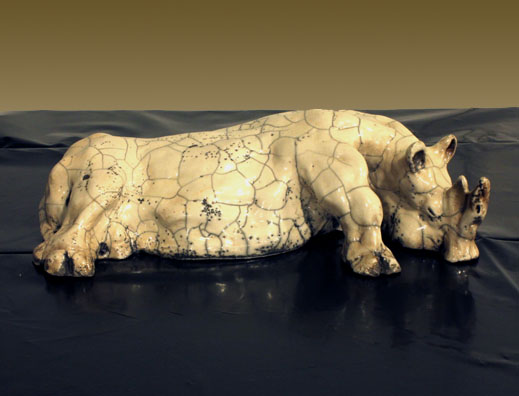
What kind of rhinoceros?
Raku!
Gesundheit!
Well, we suppose same explanation is needed although today with the Fount of All Knowledge you can learn about raku ceramics with a click of a mouse.
Raku is a type of Japanese ceramic developed in the sixteenth century and distinguished by the firing method. Most ceramics are fired from a kiln that is heated slowly over a number of hours and then allowed cooled to room temperature. The ceramics can remain in the kiln 8 to 24 hours. Usually you have a lower temperature bisque fire and a second firing after the glaze is added to the bisqueware.
Raku is also fired in two steps. The first is a more or less normal bisque firing - 1600 to 1700 degrees Fahrenheit. However, for the second firing, the bisqueware is glazed or otherwise finished (sometimes coated with fine clay called terra sigillata or "sealed clay") and heated up much more rapidly often in a hot kiln. The second time in the kiln is only about 45 minutes and also at the lower temperatures of 1600 - 1700 degrees Fahrenheit. Unlike normal ceramics you don't fire using pyrometric cones to determine when the firing is done but usually you simply (carefully) take a look in the kiln and use experience.
But the distinguishing visual characteristic of raku ceramics is the glaze. It is removed from the kiln and then either in a container with combustible material (like paper or hair) which produces a lot of smoke and covered. If you let the ceramic cool for a couple of minutes, this produces an oxidized glaze. If you put the ceramic directly into the container without cooling this produces the reduced glaze. The reduced glaze means the oxygen in the glaze minerals is removed by the carbon of the smoke and you get some metals actually at the surface. This produces a shiny look characteristic of the reduced raku.
The oxidized glazes usually don't have the metallic sheen. But if you use a "clear" glaze - like the one in the figure above - the cooling shrinks the glaze which fractures to produce the "crackle" designs. The cracks expose the unglazed ceramic which is darkened by the smoke. So you get the nice pattern of gray or black lines.
Generally raku also has particles of "refractory" materials - called "grog" (not to be confused with the popular drink of the various naval forces). This helps prevent the clay from breaking from the sudden changes in temperature.